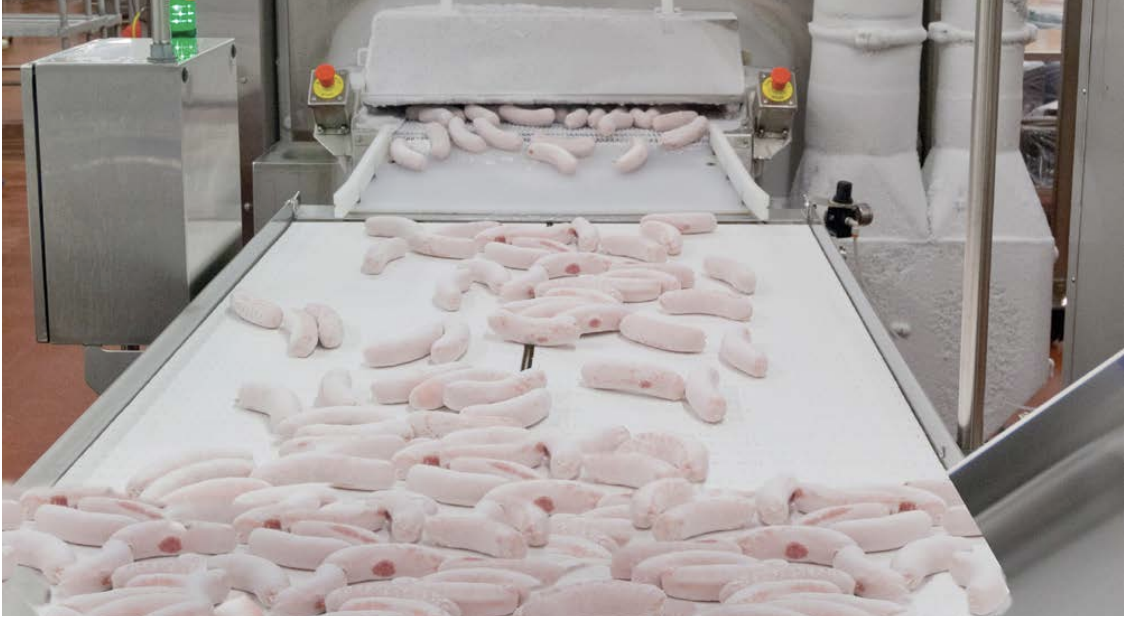As a food processors grow, scaling up production quickly in order to meet demand can be a serious operational challenge. One common issue is capacity limitations on existing chilling and freezing production lines, which can pose a challenge to increase productivity and throughput.
Finding the right solution is rarely simple, because it requires a balancing act of factors including:
- Cost
- Capacity
- Appropriateness for the type(s) of product you’re running
- Space Constraints (e.g., line configuration)
- Available Floorspace
If demand for your products is soaring, but you’re unable to make as much as you’d like due to current equipment capacity constraints, then an upgraded freezer technology can provide a well-suited solution.
For some processors, switching to a cryogenic impingement freezer may be the best way to bring their business to the next level. That’s because impingement freezers can provide significantly greater capacity within the existing footprint either as a standalone unit or as a cryogenic assist to an already maximum capacity freezing system.
In this blog, we provide a concise overview of impingement freezer technology, how it works, and why it can be so valuable for food processors.
What is impingement freezing technology?
Impingement technology is a form of convective heat transfer in which high-velocity gas flow is directed to the top and bottom surfaces of the food product, improving heat transfer and reducing freezing time. Impingement technology is available in mechanical systems, which use air cooled by refrigerant, or with cryogenic technology, which uses liquid nitrogen.
How does an impingement freezer work?
Impingement freezing works by pushing cold air or even colder nitrogen through tiny holes or slots at high velocity to break down the thermal layer surrounding the food product. As that layer is minimized, more convective heat transfer can be delivered to the product, meaning a processor can achieve a significantly faster freeze.
Cryogenic Food Preservation with Impingement Freezers
Impingement freezers can be used to quick freeze nearly all frozen foods but are ideal for items with large surface to volume ratios. For proteins, these are foods such as chicken and fish filets and meat or vegetable patties or sausages. Other examples include prepared foods such as cookies, pizza or garlic bread.
Learn how a growing chicken sausage processor was able to double line capacity to meet demand in the same footprint.
Food Preservation: What are the benefits of impingement freezing technology?
Cryogenic impingement freezing technology can deliver some of the highest chilling and freezing rates compared to other freezers on the market, reducing the amount of valuable floorspace required. This flexible solution is available both as a tunnel freezer and an individually quick-frozen (IQF) freezer (whose belts move up and down continuously to minimize product clumping and sticking for sliced or diced products).
Cryogenic impingement freezers significantly outperform regular cryogenic freezing tunnels. Impingement freezer’s rapid heat transfer and faster freeze:
- Benefits overall productivity with highest throughput
- Locks in product moisture and creates a quick crust freeze to reduce product dehydration (and increase product yield).
- Preserves the overall product quality in terms of flavor, taste and appearance, increasing customer satisfaction.
How to Choose the Right Impingement Freezer
When choosing an impingement freezer, it is important to carefully select a solution that is well suited to your specific operational requirements. When considering an impingement freezer investment, be sure to ask the vendor about:
- Hygienic Standards: freezers should be designed to be readily accessible for cleaning and servicing and certified to all relevant food hygiene standards.
- Implementation Support: Can the vendor help implement the freezing solution at your facility? Some vendors offer turnkey installation with onsite support during startup with operator and maintenance training.
- Long-Term Support: How many impingement freezers does your vendor have operating? It’s important they have an extensive spare parts inventory and customer support to maximize the full lifecycle value of your impingement freezer.
Messer has over 20 years of experience implementing cryogenic impingement freezing solutions for food processors.
For more information on how cryogenic impingement freezers and other cryogenic freezing technology can help you grow your food manufacturing business, we encourage you to contact the Messer food processing team. We can provide advice and/or a complimentary production process assessment.



Comments
Messer makes no warranty of any kind with respect to the subject matter, the completeness, or accuracy of this blog. Messer is not responsible for any actions (or lack thereof) taken as a result of relying on or in any way using information contained in this blog. In no event shall Messer be liable for any damages resulting from reliance on or use of information in this blog. Readers should take advice from a qualified professional when dealing with specific situations. Descriptions of, or references or access to, other publications within this blog do not imply endorsement of those publications. This blog may contain technical inaccuracies and changes to the information may be made at any time.
Gas products are hazardous. The use or misuse of gas products involves serious risks, including injury, disability and death. Users of gas products must use the Safety Data Sheets for the gas products to warn their employees and others who are exposed to the gas products or hazards associated with such products.